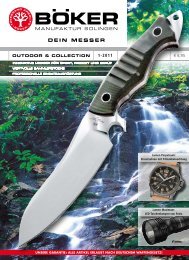Boker Barbers Corner | BUSA Edition 2017 / 2018
You also want an ePaper? Increase the reach of your titles
YUMPU automatically turns print PDFs into web optimized ePapers that Google loves.
BÖKER MANUFAKTUR SOLINGEN<br />
13<br />
CONSTRUCTION AND MANUFACTURING<br />
Forging and Hardening<br />
The forge and hardening shop for<br />
our carbon steel straight razors<br />
uses the proven silver steel, which<br />
is very tough and elastic, despite<br />
its excellent edge retention. The<br />
raw material is a rod which is cut<br />
to length, creating the so called<br />
splitter. The splitter is heated until<br />
red hot, and drop forged with a<br />
1,500 lb rammer. Next, the slugs<br />
have to cool to 392°F for two days<br />
in an annealing furnace. Then the<br />
excess material created during the<br />
forging process, the "wings," are<br />
trimmed. The slugs are once again<br />
straightened in a 200-ton press,<br />
before going to the hardening shop.<br />
In the hardening shop, the slugs are<br />
hardened and annealed in order to<br />
achieve the optimal combination of<br />
edge retention and elasticity for the<br />
material.<br />
In the Grinding Shop - Production<br />
of the Extra Hollow Grind with Belly<br />
In the grinding shop, the extra<br />
hollow grind with belly is created.<br />
The slugs are ground in 18 individual<br />
steps, from rough grinding, to<br />
milling, to glazing. Between each<br />
step, the blades are cleaned,<br />
controlled, and straightened when<br />
necessary. We exclusively grind our<br />
straight razor blades extra hollow<br />
with belly. The belly lies in front<br />
of the strong hollow section and<br />
just behind the edge, which has<br />
a small hollow grind itself. The<br />
belly is the only way in which the<br />
blades can be ground out so thin<br />
and still retain sufficient stiffness,<br />
despite their elasticity. There are<br />
only a handful of the best and most<br />
specialized grinders in the world<br />
that have mastered this ultimate<br />
skill in straight razor production.<br />
Depending on the model, the last<br />
step is the matting or polishing of<br />
the blade.<br />
Finally, the blade is honed by hand<br />
on several bench whetstones with<br />
increasingly finer grits. After the<br />
final stropping, the sharpness of the<br />
straight razor is tested on a freely<br />
suspended human hair.<br />
In the Scales Department<br />
The scales department manually<br />
affixes nickel silver pins, washers,<br />
and spacers to the blades. Wood<br />
and stag require special dexterity,<br />
as these natural materials can tear<br />
when too much pressure is applied.<br />
Widths and Heads<br />
The shapes of straight razors are<br />
mainly determined by national<br />
and local traditions and personal<br />
preferences. However, the different<br />
shapes have different benefits. The<br />
widths of the blades are given in<br />
inches. An 8/8" blade is one inch<br />
wide, a 4/8" blade half an inch wide.<br />
The 5/8" blade is the most common<br />
POINT/HEAD SPINE ETCHING/LASERING<br />
HOLLOW<br />
SCALE<br />
EDGE<br />
SCALE INLAY<br />
width. Below 4/8", the blades are<br />
used mainly by hairdressers to shave<br />
the neck, or for contouring. A wide<br />
blade glides over the skin more<br />
steadily, due to its weight, and can<br />
take on more soap and beard hairs<br />
before having to be wiped. Narrow<br />
blades are better for working on<br />
inside curves and contouring. There<br />
are various point/head shapes as<br />
well - the rounded point, the straight<br />
point, the French point, and the<br />
Spanish point. The round point is<br />
the easiest to handle. It is thus very<br />
suitable for beginners. The defined<br />
edges of the other heads provide<br />
benefits for the precise creation of<br />
contours.<br />
SHOULDER<br />
TANG STAMP<br />
TANG/SHANK<br />
SPACER PIN<br />
PIVOT PIN<br />
CROSS SECTION<br />
OF BLADE<br />
BELLY<br />
TANG


















